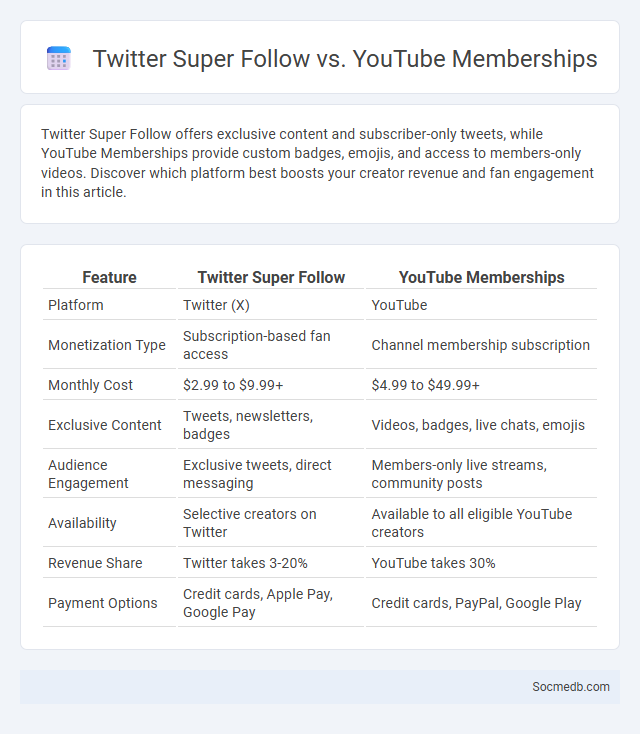
Photo illustration: Twitter Super Follow vs YouTube Memberships
Twitter Super Follow offers exclusive content and subscriber-only tweets, while YouTube Memberships provide custom badges, emojis, and access to members-only videos. Discover which platform best boosts your creator revenue and fan engagement in this article.
Table of Comparison
| Feature | Twitter Super Follow | YouTube Memberships |
|---|---|---|
| Platform | Twitter (X) | YouTube |
| Monetization Type | Subscription-based fan access | Channel membership subscription |
| Monthly Cost | $2.99 to $9.99+ | $4.99 to $49.99+ |
| Exclusive Content | Tweets, newsletters, badges | Videos, badges, live chats, emojis |
| Audience Engagement | Exclusive tweets, direct messaging | Members-only live streams, community posts |
| Availability | Selective creators on Twitter | Available to all eligible YouTube creators |
| Revenue Share | Twitter takes 3-20% | YouTube takes 30% |
| Payment Options | Credit cards, Apple Pay, Google Pay | Credit cards, PayPal, Google Play |
What Is Twitter Super Follow?
Twitter Super Follow is a subscription feature that allows users to monetize their content by offering exclusive tweets, behind-the-scenes updates, and subscriber-only interactions for a monthly fee. This feature helps creators build a closer community with their followers while generating recurring revenue. Subscribers gain access to bonus content that is not available to regular followers, enhancing engagement and loyalty.
Overview of YouTube Memberships
YouTube Memberships provide creators with a platform to offer exclusive perks such as members-only videos, live chats, and badges in exchange for a monthly fee. This feature enhances audience engagement by fostering a closer community while generating consistent revenue beyond ad earnings. Members gain access to unique content and experiences, supporting their favorite channels directly.
Super Follow: Features and Functionality
Super Follow offers exclusive content and community access, enabling creators to monetize their social media presence effectively. This feature allows you to provide subscribers with perks like bonus tweets, subscriber-only newsletters, and access to private groups. Enhanced engagement tools within Super Follow help boost interaction and build a loyal, paying fanbase on platforms like Twitter.
Monetization Opportunities for Creators
Social media platforms offer diverse monetization opportunities for creators, including ad revenue sharing, sponsored content, and fan subscriptions. Features like YouTube's Partner Program, Instagram Shopping, and TikTok Creator Fund enable creators to earn based on engagement and audience size. Leveraging affiliate marketing and merchandise sales further amplifies income potential across platforms.
Audience Engagement and Community Building
Social media platforms drive audience engagement by enabling interactive content such as polls, live videos, and user-generated posts that foster real-time communication. Effective community building relies on consistent brand messaging, active moderation, and meaningful responses that create a sense of belonging and trust. Metrics like engagement rate, follower growth, and sentiment analysis provide insights to optimize strategies and deepen connections.
Pricing Structures Compared
Social media platforms offer diverse pricing structures, ranging from freemium models to subscription-based services and pay-per-click advertising options. You can choose plans depending on your budget, targeting needs, and ad exposure goals, with costs influenced by factors like audience size, engagement rates, and ad formats. Understanding each platform's pricing tiers and promotional tools helps optimize spend and maximize your social media marketing ROI.
Platform Policies and Revenue Shares
Social media platform policies directly impact content moderation, user engagement, and monetization opportunities, influencing how creators and businesses navigate compliance. Revenue shares vary widely, with major platforms like YouTube offering up to 55% of ad revenue to content creators, while others may provide different splits based on the monetization model. Understanding these policies and revenue structures ensures your content strategy maximizes profitability and platform adherence.
Content Types and Exclusive Perks
Social media platforms offer diverse content types including videos, stories, reels, and live streams to engage audiences effectively. Exclusive perks such as member-only content, early access to new features, and platform-specific badges boost user loyalty and encourage active participation. These strategies enhance user experience while driving higher engagement rates and retention.
Ease of Use for Creators and Subscribers
Social media platforms are designed with intuitive interfaces that simplify content creation and engagement for both creators and subscribers, enhancing user experience and retention. Tools such as drag-and-drop editors, pre-designed templates, and smart content scheduling enable creators to produce high-quality posts efficiently. Subscribers benefit from personalized feeds and easy interaction features like one-click likes, comments, and shares, fostering stronger community connections.
Choosing the Best Subscription Platform
Choosing the best subscription platform for your social media content depends on factors like audience size, content type, and revenue goals. Platforms such as Patreon, Substack, and OnlyFans offer varying features including customizable membership tiers, integrated payment processing, and audience analytics. You can maximize your earnings and engagement by selecting a platform that aligns closely with your content style and subscriber expectations.
 socmedb.com
socmedb.com